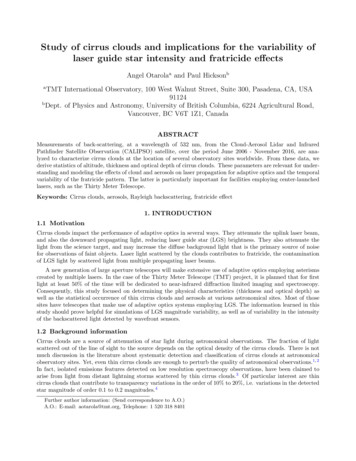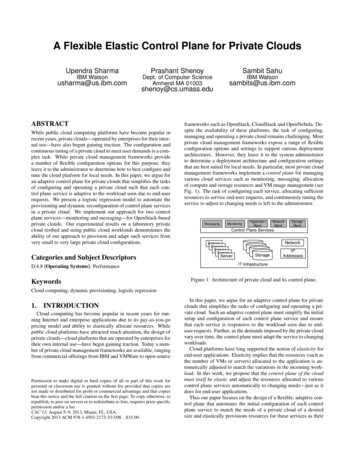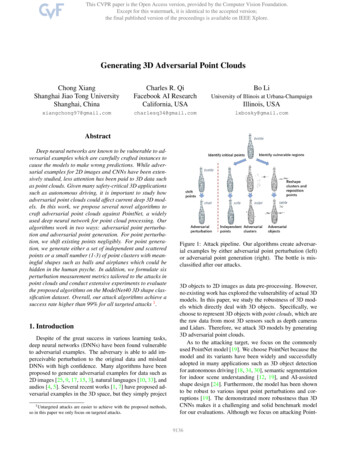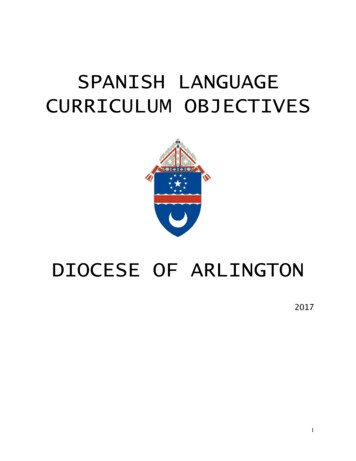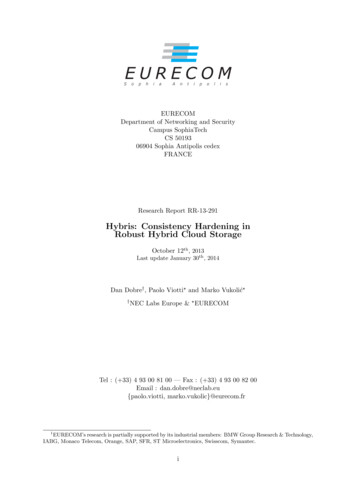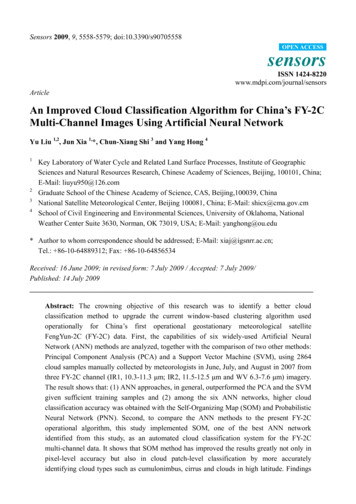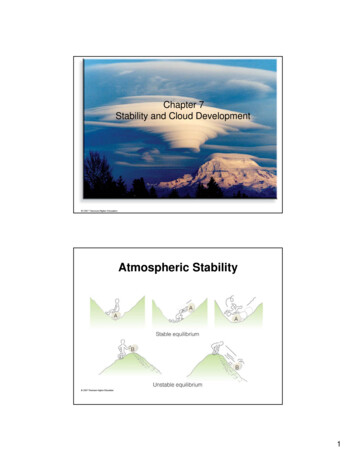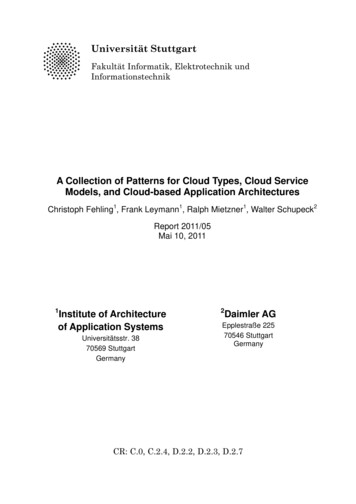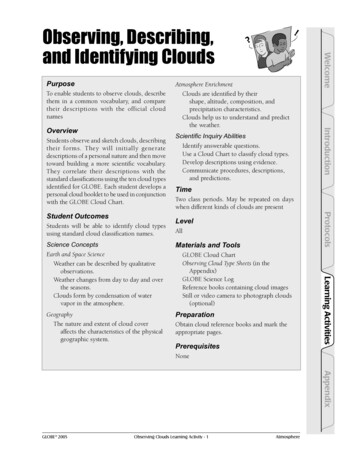
Transcription
PurposeTo enable students to observe clouds, describethem in a common vocabulary, and comparetheir descriptions with the official cloudnamesStudents observe and sketch clouds, describingtheir forms. They will initially generatedescriptions of a personal nature and then movetoward building a more scientific vocabulary.They correlate their descriptions with thestandard classifications using the ten cloud typesidentified for GLOBE. Each student develops apersonal cloud booklet to be used in conjunctionwith the GLOBE Cloud Chart.Students will be able to identify cloud typesusing standard cloud classification names.Scientific Inquiry AbilitiesIdentify answerable questions.Use a Cloud Chart to classify cloud types.Develop descriptions using evidence.Communicate procedures, descriptions,and predictions.TimeTwo class periods. May be repeated on dayswhen different kinds of clouds are presentProtocolsStudent OutcomesAtmosphere EnrichmentClouds are identified by theirshape, altitude, composition, andprecipitation characteristics.Clouds help us to understand and predictthe weather.IntroductionOverview?WelcomeObserving, Describing,and Identifying Clouds!LevelAllMaterials and ToolsGeographyThe nature and extent of cloud coveraffects the characteristics of the physicalgeographic system.PreparationGLOBE Cloud ChartObserving Cloud Type Sheets (in theAppendix)GLOBE Science LogReference books containing cloud imagesStill or video camera to photograph clouds(optional)Obtain cloud reference books and mark theappropriate pages.PrerequisitesLearning ActivitiesScience ConceptsEarth and Space ScienceWeather can be described by qualitativeobservations.Weather changes from day to day and overthe seasons.Clouds form by condensation of watervapor in the atmosphere.NoneAppendixGLOBE 2005Observing Clouds Learning Activity - 1Atmosphere
BackgroundAccurate weather forecasting starts with carefuland consistent observations. The human eyerepresents one of the best (and least expensive)weather instruments. Much of what we knowabout the weather is a result of direct humanobservation conducted over thousands of years.Although being able to identify clouds is usefulin itself, observing clouds on a regular basis andkeeping track of the weather associated withcertain kinds of clouds will show students theconnection between cloud types and weather.Recognizing cloud types can help you predictthe kind of weather to expect in the near future.We do not describe those connections here, butthere are numerous weather books that can helpyou and your students make them. Inviting a localmeteorologist to visit your class and to talk withthe students is a sure way to stimulate interestin the relationship between clouds and weatherpatterns.In this activity, we ask students to look carefullyat clouds, sketch them, and describe them intheir own words before using the official names.The activity can be repeated on different dayswhen different kinds of clouds are present. Infact, if you can be spontaneous, it would be niceto take a break and do some outdoor “cloudwork” whenever a new kind of cloud appearsin the sky. Over time, students can build up aconsiderable familiarity with cloud types. If youcannot always take the students outside wheninteresting clouds appear, perhaps you canobserve them through a window.Students Develop a Personal CloudBookletStudents should develop, either in their GLOBEScience Logs or in separate cloud booklets, anindividual, personal set of notes on clouds andcloud types. They should devote one page oftheir GLOBE Science Logs to each individualcloud type they identify. They can include notonly their own observations and descriptions butalso photographs of clouds that they take or thatthey clip from other sources. On any given daystudents may observe several kinds of clouds inGLOBE 2005the sky at the same time. If several types of cloudsare present, they should record each of the typeson a separate page of their GLOBE Science Logs.Identifying and Classifying CloudsThe GLOBE protocol asks you to identify tencommon types of clouds. The names used for theclouds are based on three factors: their shape, thealtitude at which they occur, and whether they areproducing precipitation.1. Clouds come in three basic shapes:cumulus clouds (heaped and puffy)stratus clouds (layered)cirrus clouds (wispy)2. Clouds occur in three altitude ranges(specifically, the altitude of the cloudbase):High clouds (above 6,000 m), designatedby “cirrus or cirro-” Cirrus Cirrocumulus CirrostratusMiddle clouds (2,000 - 6,000 m),designated by “alto-” Altocumulus AltostratusLow clouds (below 2,000 m), no prefix Stratus Nimbostratus Cumulus Stratocumulus CumulonimbusNote: While both cumulus and cumulonimbusclouds may have their bases starting below2,000 m, they often grow thick enough toextend into the middle or even high range. Thus,they are often referred to as “clouds of verticaldevelopment.” Only high clouds are wispy andso the term cirrus has become synonymous withwispy as well as referring to high clouds.3. Clouds whose names incorporate theword “nimbus” or the prefix “nimbo-” areclouds from which precipitation is falling.4. Contrails are linear clouds formed aroundsmall particles in jet aircraft exhaust.Observing Clouds Learning Activity - 2Atmosphere
Nimbostratus clouds are larger horizontally thanvertically. The rainfall associated with nimbostratustypically is low to moderate in intensity, but fallsover a large area for an extended period of time.Cumulonimbus have dark bases and puffy tops,often anvil-shaped, and are sometimes called“thunderheads.” They tend to produce heavyprecipitation, typically accompanied by lightningand thunder.It should not be hard to find photographs of cloudsin books, charts, and magazines. However, thestudents will enjoy taking their own photographsof clouds. Introduce this as an activity after theyhave sketched and described clouds in their ownwords. Video photography of clouds in motionalso presents a new perspective on cloud formationand behavior, particularly if you can use a tripodand time-lapse photography.ProtocolsCloud Identification TipsSeveral things are useful to know in identifyingand naming clouds according to the officialclassifications:Learning ActivitiesClouds that are wispy and high in the sky arealways cirrus of one type or another. If the cirrusclouds contain waves or puffs, then they arecirrocumulus. If they form continuous layersthat seem to cover the sky high up, they arecirrostratus. Contrails occur at high levels too,and are very linear cloud features.Clouds at middle altitudes are designated by theprefix “alto-.” If in layers, they are altostratus; if inheaps and puffy, they are altocumulus.Clouds that form at low altitudes (below 2,000 m)are either of the cumulus or stratus family. Cloudsin the cumulus family are puffy and heaped.Clouds in the stratus family form in layers or sheetsthat cover broad expanses of sky.Observing Clouds Learning Activity - 3AppendixLow clouds that are dark, threatening andactually producing rain receive the designation“nimbus.” Nimbostratus clouds cover the entiresky with broad sheets and produce steady rain.GLOBE 2005IntroductionUsing PhotographyWelcomeThese are indeed clouds, caused directlyby human activity, and are of greatinterest to researchers. We distinguishthree subtypes:1. Short-lived contrails: obvious tailbehind a plane; Do not remain afterplane passes;2. Persistent, non-spreading contrails:obvious contrails (linear, narrowfeatures) that do not appear to dissipatesignificantly, or to show signsof spreading, and that remain long afterthe airplanes that created them have leftthe area; Each contrail subtends a narrowangle in the sky;3. Persistent, spreading contrails: obviouslinear cirrus-type clouds with a diffuseappearance; Each contrail subtends awider angle in the sky.Atmosphere
Part 1: Describing Clouds InYour Own WordsWhat To Do and How To Do It1. Organize the students into two-personteams. Send them outside with theirGLOBE Science Logs to an open locationto observe the clouds. Each student shoulddraw a detailed sketch of the clouds in thesky. If there are several different kinds ofclouds present, they should sketch eachspecific kind on a separate page of theirnotebooks.2. Each student should record the date andtime of day and describe the appearanceof the clouds next to the sketch. Theyshould use as many words as necessaryto describe the appearance of the clouds.Emphasize that there are no right orwrong answers and that they should usewhatever words seem appropriate tothem. Some possible student responses:Size: small, large, heavy, light, dense, thickShape: fluffy, stringy, cottony, lumpy,torn, smooth, patchy, sheets, ragged,looks like a.Color: gray, black, white, silvery, milkyDescription: thunderclouds, menacing,threatening, gloomy, enveloping,beautiful, streaked, foggy, bubbly,scattered, moving, swirling3. Upon returning to the class, pairs shouldjoin together to share descriptions. Askeach group of four to compile a “grouplist” of all the words they used to describeeach cloud type they observed. Theyshould select the words they think arethe best ones for describing the cloudsthey saw.4. Using the GLOBE Cloud Chart, studentsshould match their sketches with one ofthe photographs and record the scientificname of the cloud type next to theirsketch.GLOBE 2005Part 2: Comparing YourDescriptions to the OfficialDescriptionsWhat To Do and How To Do It1. (You may choose to postpone thisdiscussion until the class has accumulateddescriptions of several different kinds ofclouds.)Initiate a class discussion. Ask one fourperson group to draw a cloud sketchon the board and record the wordstheir group used to describe the cloud.If several different clouds have beenobserved, have a different group do eachtype. Ask other groups to contributeadditional words they used to describethese clouds.Ask the students to group the wordsthey used into clusters that seem togo together. Ask them to name thespecific features of the clouds (suchas size, shape, color, altitude, or otherfeatures) to which these clusters refer.Do these clusters represent the maincloud features to which they think anobserver should pay attention? Arethere any cloud features that have notbeen included? What would they say isthe basis of their system, that is, whatfeatures of clouds does it pay attentionto?2. Ask the students to indicate the “official”names for the clouds pictured on theboard. Explain that the official systemused to classify clouds relies upon threefeatures of clouds: shape, altitude, andprecipitation. Compare the officialsystem to the classification system theydeveloped on their own. What cloudfeatures does each include and omit?Ask students which of their words theywould use to describe each of thesecloud families:stratus cloudscumulus cloudscirrus cloudsnimbus cloudsObserving Clouds Learning Activity - 4Atmosphere
Younger students can describe clouds in termsof their basic family type: cirrus, cumulus, andstratus. They can also describe the height of theclouds: low, medium, or high; their shape: large orsmall; and their color: white, gray, or black.Cloud Game #2: Groups of students can generatequestions about clouds: appearance, shape,altitude, and percentage of dominant cover. On a3” x 5” index card write the statement as an answer.For example: “Scattered Clouds” is the answerto the question, “What is the cloud cover whenbetween a tenth and a half of the sky is coveredwith clouds?” Divide the class into teams to play.Players respond to the answer cards in the formof a question (see above).Learning ActivitiesThis activity can present interesting possibilitiesfor collaboration with an art teacher or aliterature teacher, each of whom can contributea different, perhaps nonscientific, perspective onthe description of clouds.Cloud Game #1: Have each student create a setof 3” x 5” index cards that includes names of theten cloud types. A second set of cards includesillustrations of each of the ten types. Pairs ofstudents combine cards, turning them face down.Partners alternate turning over two cards at atime, attempting to locate a match. A successfulmatch results in another turn. Play continues untilall cards have been matched. The winner is thepartner with the most matched pairs.Further InvestigationsExamine the correlation between wind and clouds.Chart the wind direction and speed for eachobservable cloud type.Explain the connection between the hydrologiccycle and atmospheric conditions.Observing Clouds Learning Activity - 5AppendixSatellite and shuttle photos allow observationsof the dynamics of our atmosphere and theexamination of large-scale phenomena thatare not possible from land. Use space-basedimagery to predict weather or to track storms.Consider the merits and disadvantages of spaceimages versus local meteorological informationand data.GLOBE 2005ProtocolsOlder students can correlate cloud types withthe appearance of certain types of weather. Seethe Cloud Watch Learning Activity. Studentsalso can pay attention to the sequence of cloudtypes over the course of several days and caninvestigate the factors that cause clouds toform.Create cloud games to practice identificationskills and concepts:IntroductionAdaptations for Younger and OlderStudentsTrack storms and clouds from a distance to aidin understanding local weather conditions. Usebinoculars to study clouds and their formationsfrom a distance. Use local maps to help identifythe distance of landmarks and the speed atwhich clouds are moving.Welcome3. Repeat the observation, sketching, anddescription of different cloud types onsubsequent days as new clouds appearin your sky. Have students develop aseparate page of their GLOBE ScienceLogs for each new cloud type theyobserve. Have them record both theofficial name of the cloud and their ownpreferred descriptions of it. Continueto discuss the basis for the officialclassification system.Atmosphere
using standard cloud classification names. Science Concepts Earth and Space Science Weather can be described by qualitative observations. Weather changes from day to day and over . Clouds come in three basic shapes: cumulus clouds (heaped and puffy) stratus clouds (layered) cirrus clouds (wispy) 2. Clouds occur in three altitude ranges
